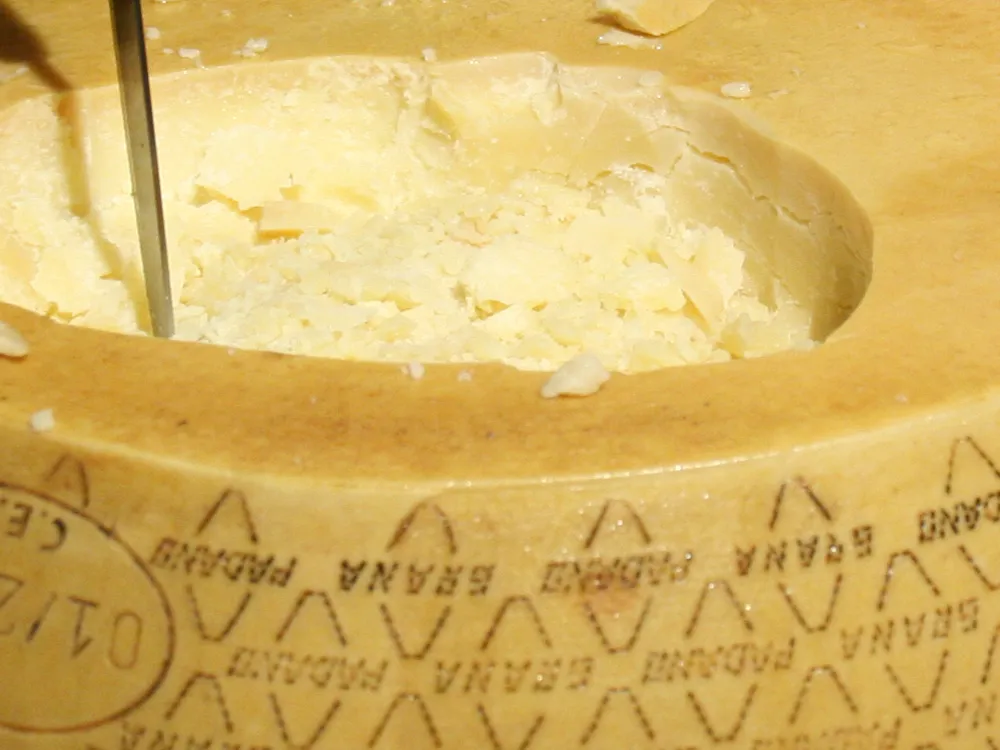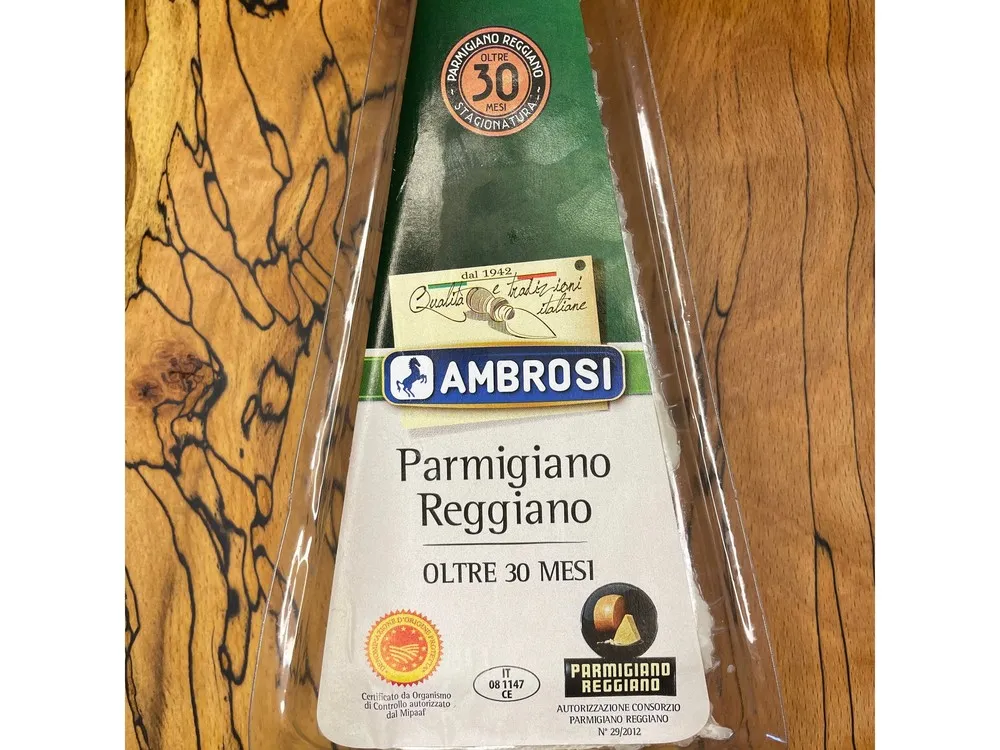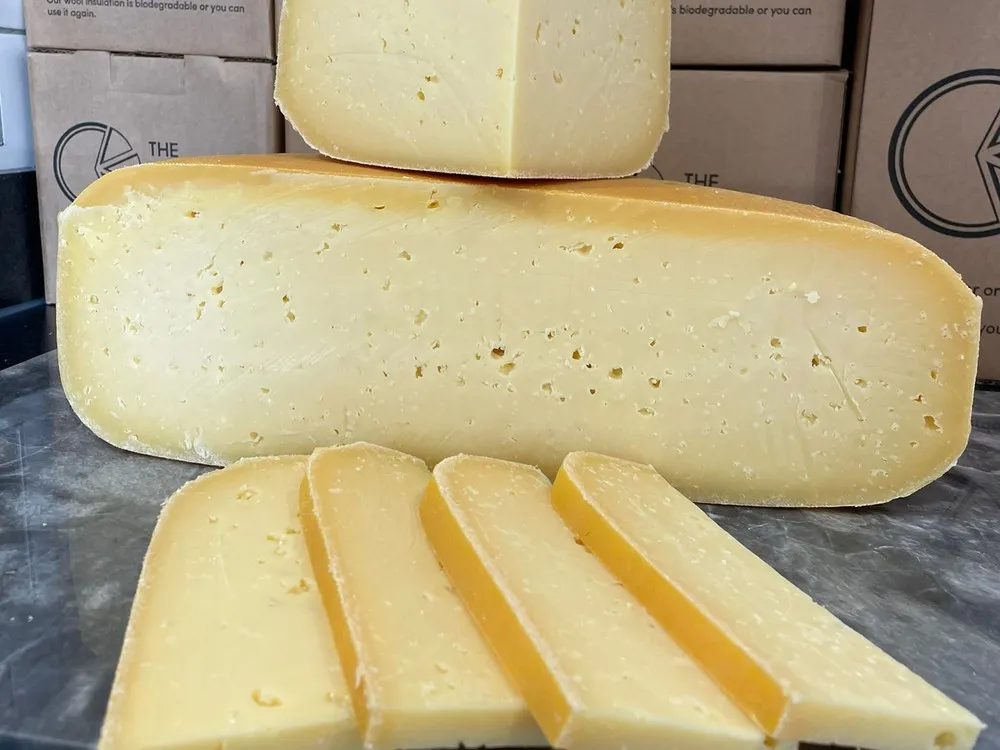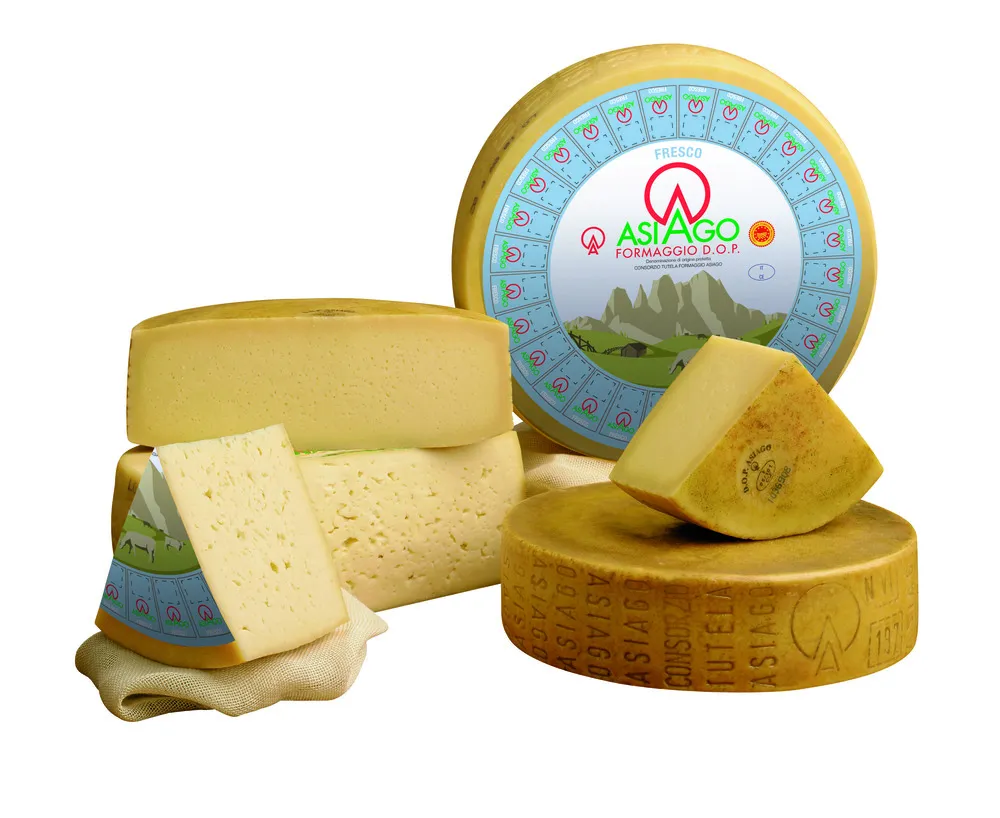Grana Padano
What Is Grana Padano? What Does Grana Padano Cheese Taste Like?
Grana Padano is an Italian cow’s milk cheese that has been enjoyed for centuries. It is a hard cheese with a pale yellow color and a firm, crumbly texture.
Grana Padano is often compared to Parmigiano Reggiano, another famous Italian cheese, but it has its own unique flavors and characteristics.
It is named after the Grana (grainy) texture of the cheese and the Padano region in northern Italy, where it originated.
Grana Padano cheese has been produced for almost 1,000 years and is one of the most popular and widely consumed cheeses that has ever received the Protected Designation of Origin (PDO) status.
What Does Grana Mean?
Grana refers to a family of demanding, hard-working, mature cheeses from Italy with a granular, flaky texture and is mainly used for grating. Around the world, Grana is a generic term used to define three main varieties of cheeses, namely - Parmigianino Reggiano, Grana Padano, and Grana Trentino, and other smaller variants like Granone Lodigiano, Trentingrana, and Gransardo. However, the word 'Grana' is legally protected by Grana Padano Protected Designation of Origin in Europe. Only Grana Padano can use the term to sell its produce in EU countries.
Of course, Parmigiano Reggiano and Grana Padano are the most popular Grana Italian cheeses. True Parmigianino Reggiano, named after the Provinces of Parma, Reggio Emilia, Modena, Bologna, and Mantua, where it is produced, has a hard, gritty texture and is fruity and nutty in taste.
On the other hand, Grana Padano refers to the valley Pianura Padana, where it is made. Though similar to Parmigianino Reggiano, young Grana Padano is slightly less crumbly, milder, and less complex than its famous, aged kin. Grana Trentino follows the same method to produce Parmigianino Reggiano but is made in the province of Trento, giving it its name.
All three main varieties of Grana cheese carry the label DOP (Denomination of Protected Origin), guaranteeing their authenticity and the origin of their production methods.
How Is Grana Padano Made? What Are Grana Padano’s Ingredients?
Grana Padano is made from unpasteurized cow's milk. The milk is usually sourced from the Po River Valley in northern Italy, where the cows graze on lush green pastures. It is important to note that Grana Padano does not contain any animal rennet, making it suitable for vegetarians.
The production of Grana Padano cheese is a time-honored, process that follows strict guidelines to ensure its quality and authenticity. After the milk is collected, it is heated and mixed with whey and natural whey culture, which kickstarts the fermentation process.
Once the curds have settled, they are molded into large wheels and immersed in a brine solution to enhance the flavor and preserve the cheese. The wheels are then aged for a minimum of 9 months, during which time they are regularly turned and monitored for quality. The result is a delicious and versatile cheese with a rich, nutty flavor and a crumbly texture, perfect for grating over pasta or enjoying on its own. Some varieties are left to age for up to 24 months or more, which creates a firmer, more granular texture that becomes crumbly as it ages. The flavor also matures, bringing savory, nutty, and slightly sweet notes to an already flavorful cheese. Grana Padano has a pale yellow or straw-colored interior with a natural rind. It is available at different ripening stages: Grana Padano (9 to 16 months), Grana Padano oltre 16 mesi (over 16 months), and Grana Padano Riserva (over 20 months). All three main varieties of Grana cheese carry the label DOP. (Denomination of Protected Origin), guaranteeing their authenticity and the origin of their production methods.
Is Grana Padano Cheese Pasteurized?
No, most, Grana Padano is made from raw, unpasteurized milk. This means that the milk used in the cheese production process hasn’t been heated to kill harmful bacteria.
Grana Padano is a complex hard, slow-ripened, semi-fat cheese from the Po River Valley in northern Italy. It is often compared to Parmigiano Reggiano, another famous Italian cheese, but Grana Padano has its unique characteristics. The cheese is aged for a minimum of nine months, during which time it develops a granular texture and a nutty, slightly sweet flavor.
Grana Padano is a versatile cheese that can be enjoyed in various ways. It can be grated over pasta dishes, salads, and soups, adding a rich umami flavor. The cheese can also be enjoyed independently, paired with fruits, nuts, or a drizzle of honey. Additionally, Grana Padano pairs well with wines, making it a popular choice for cheese boards and wine tastings.
What Kind of Cheese Is Grana Padano?
Grana Padano is classified as a grating cheese, which means it is often used to enhance the flavor of various dishes. It is generally aged for 16- 20 months. However, some wheels spend as long as 24 months maturing whilst others are considered ready for market after only nine. This process helps build complexity and richness into the cheese.
Grana Padano cheese is a hard, granular cheese originating in northern Italy's Po River Valley. It is made from partially skimmed milk that is heated and curdled before being molded into large wheels and immersed in a brine solution. The cheese is then aged in temperature-controlled rooms, where it develops its unique flavor profile.
One of Grana Padano's distinguishing characteristics is its versatility in the kitchen. It can be grated over pasta dishes, blended into risottos, or sprinkled over salads to add a nutty and savory flavor. The cheese can also be enjoyed on its own, paired with fruits, nuts, and honey for a simple yet elegant appetizer.
What Are Some of Grana Padano’s Uses? What Is Grana Padano Used For?
Grana Padano is incredibly versatile and can be used in a wide range of dishes. It can be enjoyed on its own as a cheese course, grated over pasta or risotto, or shaved on top of salads. Its nutty, savory flavor pairs well with both sweet and savory ingredients.
Grating
One of the most common uses is grating Grana Padano over dishes like pasta, risotto, soups, salads, and vegetables. The hard, grainy texture makes it ideal for grating into thin shavings or coarse pieces to add a savory, nutty flavor.
Snacking
Grana Padano can be enjoyed on its own as a snack or part of a cheese plate. Cut into small cubes or wedges, it pairs well with fruits like grapes or figs, cured meats, olives, and bread or crackers.
Cooking
The cheese can be incorporated into various cooked dishes:
- Grated or shaved into soups, stews, and risottos to add richness
- Mixed into fillings for lasagna, stuffed pasta, etc.
- Used as a topping for baked dishes like eggplant parmigiana
Grana Padano is often melted and incorporated into sauces or used as a topping for pizza or bruschetta. Its intense flavor adds depth and richness to any dish. The possibilities are endless when it comes to incorporating Grana Padano into your culinary creations.
One classic Italian dish that showcases the deliciousness of Grana Padano is the famous Risotto alla Milanese. This creamy saffron-infused risotto is finished with a generous amount of grated Grana Padano, which not only enhances the dish's creaminess but also adds a wonderful umami flavor.
Moreover, Grana Padano can also be used in unconventional ways, such as in desserts. Try grating some over a slice of honey-drizzled pear or apple for a unique sweet and savory flavor combination that will tantalize your taste buds.
Rind Utilization
The hard rind of Grana Padano can be added to soups, stews or beans while cooking to infuse a savory, nutty flavor. It can also be crisped up in the microwave and eaten as a snack.
Where Does Grana Padano Come From?
The origins of Grana Padano cheese can be traced back to the 12th century in the Po Valley region of northern Italy, particularly to the Chiaravalle Abbey near Milan. Grana Padano is also produced in the Lombardy, Piedmont, Trentino-Alto Adige, and Veneto regions. The strict production guidelines ensure that the cheese is made using traditional methods, resulting in a high-quality product that is beloved.
The production of Grana Padano dates back almost 1000 years, with the first records of its existence found in the 12th century when Cistercian monks in the Po Valley looked for a way to preserve surplus milk from their dairy farms. Over the centuries, the production techniques have been refined and perfected, leading to the world-renowned cheese we know today.
Each wheel of Grana Padano is carefully monitored and aged for a minimum of nine months, with some varieties aging for up to 24 months or more. During this aging process, the cheese develops its signature granular texture and complex flavor profile, making it a versatile ingredient in various dishes. Whether grated over pasta, shaved on salads, or enjoyed on its own with a glass of wine, Grana Padano remains a staple in Italian cuisine and a favorite among cheese connoisseurs worldwide.
How to Pronounce Grana Padano?
Grana Padano may seem challenging to pronounce, but it is actually straightforward. It is pronounced as "GRAH-nah pah-DAH-no, " (ˌɡrɑːnə pəˈdɑːnəʊ). Remember, practice makes perfect, and once you have the pronunciation down, you'll feel a lot more confident ordering this delicious cheese.
Grana Padano Vs. Parmigiano Reggiano
Grana Padano and Parmigiano Reggiano are two iconic Italian hard cheeses that share similarities but have distinct differences. While both are made from cow's milk and aged for an extended period, Grana Padano has a larger production area spanning five northern Italian regions, allowing for a slightly more delicate and buttery flavor profile. In contrast, Parmigiano Reggiano is produced in a more localized area and made from a blend of whole and skimmed milk, resulting in a more complex, decisive flavor that intensifies with age, developing notes of citrus, dried fruit, and hazelnut.
The production methods also differ - Grana Padano uses lysozyme as a preservative, while Parmigiano Reggiano relies solely on its natural aging process. Additionally, Parmigiano Reggiano has a minimum aging requirement of 12 months, contributing to its crumbly, granular texture, while Grana Padano can be aged for as little as 9 months, lending it a slightly creamier consistency. These nuances make each cheese unique and suitable for different culinary applications, with Grana Padano often used in cooking and Parmigiano Reggiano prized for grating over dishes.
Click here to read more about the major differences between Grana Padano and Parmigiano Reggiano!
Curious For More Grana Padano Substitutes and Alternatives?
To discover more substitutes for Grana Padano, click here!
Final Thoughts
Grana Padano is a remarkable cheese that offers a delightful combination of flavors and textures. Whether enjoyed on its own or used to elevate your favorite dishes, it is a must-try for any cheese lover. Its nutty, savory taste and crumbly texture make it a versatile ingredient that can add depth and richness to a variety of culinary creations. So go ahead and explore the world of Grana Padano, and let your taste buds be delighted by this Italian treasure.

Over 200,000 page views per month, Put your store on our map!
Contact UsOther Italian cheeses:
Risotto with Grana Padano, Asparagus and Lemon
This exquisite dish combines the nutty richness of Grana Padano cheese, the vibrant essence of fresh asparagus, and the zesty allure of lemon, resulting in …
Grana Padano, a hard and aged Italian cheese with a granular texture and nutty flavour, pairs well with a variety of wines and crackers. Here are four wine types and three cracker options that generally complement Grana Padano:
Wine Pairings:
- Barolo: This robust and full-bodied red wine, made from Nebbiolo …
Grana Padano is a versatile and delicious Italian cheese that adds a unique flavor and texture to a variety of dishes. However, there may be times when you find yourself without this particular cheese in your pantry. Fortunately, there are several substitutes for Grana Padano that you can easily find …
Read MoreGrana Padano Q & A
-
Is Grana Padano Vegetarian?
Grana Padano Cheese is not considered vegetarian friendly as it is made with animal rennet. While some cheese producers …
Read More -
Is Grana Padano Lactose- Free?
Grana Padano Cheese, like most aged cheeses, has low lactose content. During the cheese-making process, most of the lactose …
Read More -
Is Grana Padano Cheese Gluten-Free?
Fortunately, Grana Padano Cheese is naturally gluten-free. For individuals who follow a gluten-free diet, it is important to be …
Read More -
Does Grana Padano Cheese Melt?
Grana Padano Cheese is a hard cheese, and while it can soften and become slightly melty when heated, it …
Read More -
How To Store Grana Padano Cheese
Storing Grana Padano Cheese correctly is essential to preserve its taste and texture. Once opened, it's best to store …
Read More -
How Long Can Grana Padano Cheese Sit Out?
Proper storage is crucial to maintain the freshness and quality of Grana Padano cheese so leaving the cheese out …
Read More -
Can You Freeze Grana Padano Cheese?
If you find yourself with leftover Grana Padano Cheese and want to prolong its shelf life, freezing is an …
Read More -
Can Dogs Eat Grana Padano Cheese?
Many dogs enjoy the occasional taste of cheese as a treat, and Grana Padano Cheese can be a delicious …
Read More -
Can Cats Eat Grana Padano Cheese?
While Grana Padano Cheese may be a tempting treat to share with your feline, it's best to avoid doing …
Read More -
Can You Eat Grana Padano Cheese While Pregnant?
Grana Padano Cheese is generally safe to eat while pregnant. During pregnancy, it's essential to be cautious about the …
Read More -
Key Differences: Grana Padano vs Parmigiano Reggiano
- Origin: Grana Padano originates from the Po River Valley, while Parmigiano Reggiano comes from specific regions in Italy, including …







